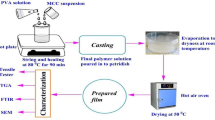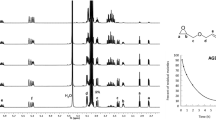Abstract
A bleached softwood kraft pulp was phosphorylated with (NH4)2HPO4 and urea at 150 ℃ for 0‒40 min, and the structures and properties of the resulting phosphorylated pulps were systematically investigated for the first time in terms of reaction time and the amount of (NH4)2HPO4 added. The phosphorous and weak acid group contents, and the weight recovery ratio increased with increasing reaction time, and were 1.9 and 4.5 mmol/g, and 114%, respectively, when the reaction time was 20 min. Therefore, numerous phosphate ester and weak acid groups were introduced into the pulp, maintaining its fibrous morphology and cellulose I crystal structure. It was found that almost all the ammonium phosphate groups in the phosphorylated pulp behaved as weak acids. The solid-state carbon-13 nuclear magnetic resonance (13C-NMR) spectrum of the phosphorylated pulp showed that neither carboxy nor carbamate groups were formed in the phosphorylated pulp; only phosphate ester groups were introduced into the pulp under the conditions used in the present study. The X-ray photoelectron spectra of the phosphorylated pulp surfaces suggested that ammonium phosphate groups were introduced into the pulp by phosphorylation. A longer reaction time or a greater amount of (NH4)2HPO4 added during phosphorylation resulted in lower water swelling behavior, indicating that some intrafiber and/or interfiber crosslinking occurred in the pulp under these conditions. The results obtained in the present study show that phosphorylated pulp fibers are suitable for the preparation of new functional cellulosic sheets and materials, in which large amounts of weak acid groups can be used as scaffolds for diverse ion-exchange sites.
Graphical abstract









Similar content being viewed by others
References
Alexander LE (1979) X-ray diffraction methods in polymer science. Robert E (ed), Kreiger Publishing, New York.
Benhamou AA, Kassab Z, Nadifiyine M, Salim MH, Sehaqui H, Moubarik A, El Achaby M (2021) Extraction, characterization and chemical functionalization of phosphorylated cellulose derivatives from Giant Reed Plant. Cellulose 28:4625–4642. https://doi.org/10.1007/s10570-021-03842-6
French A (2014) Idealized powder diffraction patterns for cellulose polymorphs. Cellulose 21:885–896. https://doi.org/10.1007/s10570-013-0030-4
Funahashi R, Okita Y, Hondo H, Zhao M, Saito T, Isogai A (2017) Different conformations of surface cellulose molecules in native cellulose microfibrils revealed by layer-by-layer peeling. Biomacromol 18:3687–3694. https://doi.org/10.1021/acs.biomac.7b01173
Ghanadpour M, Carosio F, Larsson PT, Wågberg L (2015) Phosphorylated cellulose nanofibrils: a renewable nanomaterial for the preparation of intrinsically flame-retardant materials. Biomacromol 16:3399–3410. https://doi.org/10.1021/acs.biomac.5b01117
Granja PL, Pouysegu L, Petraud M, De Jeso B, Baquey C, Barbosa M (2001) Cellulose phosphates as biomaterials. I. Synthesis and characterization of highly phosphorylated cellulose gels. J Appl Polym Sci 82:3341–3353. https://doi.org/10.1002/app.2193
Hadid M, Noukrati H, Barroug A, Sehaqui H (2021) Phosphorylated cellulose for water purification: a promising material with outstanding adsorption capacity towards methylene blue. Cellulose 28:7893–7908. https://doi.org/10.1007/s10570-021-04012-4
Hou G, Liu Y, Zhang D, Li G, Xie H, Fang Z (2020) Approaching theoretical haze of highly transparent all-cellulose composite films. ACS Appl Mater Interfaces 12:31998–32005. https://doi.org/10.1021/acsami.0c08586
ISO standard 16065–2 (2014) Pulps - determination of fibre length by automated optical analysis- Part 2: unpolarized light method
ISO standard 23714 (2007) Pulps - determination of water retention value (WRV)
Isogai A (2018) Review: development of completely dispersed cellulose nanofibers. Proc Jpn Acad Ser B 94:161–179. https://doi.org/10.2183/pjab.94.012
Isogai A (2021) Emerging nanocellulose technologies: recent developments. Adv Mater 33:2000630. https://doi.org/10.1002/adma.202000630
Isogai A, Zhou Y (2020) Diverse nanocelluloses prepared from TEMPO-oxidized wood cellulose fibers: nanonetworks, nanofibers, and nanocrystals. Curr Opin Solid St M 23:101–106. https://doi.org/10.1016/j.cossms.2019.01.001
Isogai A, Hänninen T, Saito T, Fujisawa S (2018) Catalytic oxidation of cellulose with nitroxyl radicals under aqueous conditions. Prog Polym Sci 86:122–148. https://doi.org/10.1016/j.progpolymsci.2018.07.007
Kokol V, Božič M, Vogrinčič R, Mathew AP (2015) Characterisation and properties of homo-and heterogenously phosphorylated nanocellulose. Carbohydr Polym 125:301–313. https://doi.org/10.1016/j.carbpol.2015.02.056
Larsson PT, Westlund PO (2005) Line shapes in CP/MAS 13C NMR spectra of cellulose I. Spectrochim Acta Part A 62:539–546. https://doi.org/10.1016/j.saa.2005.01.021
Lehtonen J, Hassinen J, Kumar AA, Johansson LS, Mäenpää R, Pahimanolis N, Pradeep T, Ikkala O, Rojas OJ (2020) Phosphorylated cellulose nanofibers exhibit exceptional capacity for uranium capture. Cellulose 27:1071910732. https://doi.org/10.1007/s10570-020-02971-8
Noguchi Y, Homma I, Matsubara Y (2017) Complete nanofibrillation of cellulose prepared by phosphorylation. Cellulose 24:1295–1305. https://doi.org/10.1007/s10570-017-1191-3
Noguchi Y, Homma I, Watanabe T (2020) Properties of phosphorylated cellulose nanofiber dispersions under various conditions. Cellulose 27:2029–2040. https://doi.org/10.1007/s10570-019-02922-y
Pasqui D, Rossi A, Di Cintio F, Barbucci R (2007) Functionalized titanium oxide surfaces with phosphated carboxymethyl cellulose: characterization and bonelike cell behavior. Biomacromol 8:3965–3972. https://doi.org/10.1021/bm701033u
Patoary MK, Farooq A, Zaarour B, Liu L (2021) Phosphorylated cellulose nanofibrils: structure-morphology-rheology relationships. Cellulose 28:4105–4117. https://doi.org/10.1007/s10570-021-03786-x
Preston J, Clark J, Beath W, Nimkar M (1954) Swelling powers of urea solutions on cellulose. J Text Inst Trans 45:T504–T509. https://doi.org/10.1080/19447027.1954.10807258
Rol F, Sillard C, Bardet M, Yarava JR, Emsley L, Gablin C, Léonard D, Belgacem N, Bras J (2020) Cellulose phosphorylation comparison and analysis of phosphorate position on cellulose fibers. Carbohydr Polym 229:115294. https://doi.org/10.1016/j.carbpol.2019.115294
Saito T, Isogai A (2004) TEMPO-mediated oxidation of native cellulose. the effect of oxidation conditions on chemical and crystal structures of the water-insoluble fractions. Biomacromol 5:1983–1989. https://doi.org/10.1021/bm0497769
Segal L, Creely JJ, Martin A Jr, Conrad C (1959) An empirical method for estimating the degree of crystallinity of native cellulose using the X-ray diffractometer. Text Res J 29:786–794. https://doi.org/10.1177/004051755902901003
Shinoda R, Saito T, Okita Y, Isogai A (2012) Relationship between length and degree of polymerization of TEMPO-oxidized cellulose nanofibrils. Biomacromol 13(3):842–849. https://doi.org/10.1021/bm2017542|
Sjöström E (1981) In wood chemistry: fundamentals and applications. Academic Press, New York, p 15
Sparrman T, Svenningsson L, Sahlin-Sjovold K, Nordstierna L, Westman G, Bernin DA (2019) Revised solid-state NMR method to assess the crystallinity of cellulose. Cellulose 26:8993–9003. https://doi.org/10.1007/s10570-019-02718-0
Suflet DM, Chitanu GC, Popa VI (2006) Phosphorylation of polysaccharides: new results on synthesis and characterisation of phosphorylated cellulose. React Funct Polym 66:1240–1249. https://doi.org/10.1016/j.reactfunctpolym.2006.03.006
Wickholm K, Larsson PT, Iversen T (1998) Assignment of noncrystalline forms in cellulose I by CP/MAS 13C NMR spectroscopy. Carbohydr Res 312:123–129. https://doi.org/10.1016/S0008-6215(98)00236-5
Yang H, Wang T, Oehme D, Petridis L, Hong M, Kubicki JD (2018) Structural factors affecting 13C NMR chemical shifts of cellulose: a computational study. Cellulose 25:23–36. https://doi.org/10.1007/s10570-017-1549-6
Yurkshtovich N, Yurkshtovich T, Kaputskii F, Golub N, Kosterova R (2007) Esterification of viscose fibres with orthophosphoric acid and study of their physicochemical and mechanical properties. Fibre Chem 39:31–36. https://doi.org/10.1007/s10692-007-0007-x
Zhang T, Wu M, Kuga S, Ewulonu CM, Huang Y (2020a) Cellulose nanofibril-based flame retardant and its application to paper. ACS Sustain Chem Eng 8:10222–10229. https://doi.org/10.1021/acssuschemeng.0c02892
Zhang T, Kuga S, Wu M, Huang Y (2020b) Chitin nanofibril-based flame retardant for paper application. ACS Sustain Chem Eng 8:12360–12365. https://doi.org/10.1021/acssuschemeng.0c02016
Zhang S, Li SN, Wu Q, Li Q, Huang J, Li W, Zhang W, Wang S (2021) Phosphorus containing group and lignin toward intrinsically flame retardant cellulose nanofibril-based film with enhanced mechanical properties. Compos Part B-Eng 212:08699. https://doi.org/10.1016/j.compositesb.2021.108699
Zhao M, Fujisawa S, Saito T (2021) Distribution and quantification of diverse functional groups on phosphorylated nanocellulose surfaces. Biomacromol 22:5214–5222. https://doi.org/10.1021/acs.biomac.1c01143
Zhao M, Ono Y, Noguchi Y, Fujisawa S, Saito T (2022) Comparative characterization of phosphorylated wood holocelluloses and celluloses for nanocellulose production. Cellulose 29:2805–2816. https://doi.org/10.1007/s10570-021-04013-3
Zhou Y, Ono Y, Takeuchi M, Isogai A (2020) Changes to the contour length, molecular chain length, and solid-state structures of nanocellulose resulting from sonication in water. Biomacromol 21:2346–2355. https://doi.org/10.1021/acs.biomac.0c00281
Acknowledgments
We thank Edanz for editing a draft of this manuscript.
Funding
ZF appreciates financial support from the National Natural Science Foundation of China (grant numbers 21978103 and 31700508), and from the Natural Science Foundation of Guangdong Province (grant number 2020B1515020021). GH thanks the China Scholarship Council (CSC) for financial support.
Author information
Authors and Affiliations
Corresponding authors
Ethics declarations
Conflict of interests
The authors declare that they have no known competing financial interests or personal relationships that may have influenced the work reported in this paper. The manuscript was approved for publication by all the authors.
Ethical approval
The present study did not comprise any experiments involving human participants or animals.
Additional information
Publisher's Note
Springer Nature remains neutral with regard to jurisdictional claims in published maps and institutional affiliations.
Supplementary Information
Below is the link to the electronic supplementary material.
Rights and permissions
About this article
Cite this article
Hou, G., Zhao, S., Peng, L. et al. A systematic study for the structures and properties of phosphorylated pulp fibers prepared under various conditions. Cellulose 29, 7365–7376 (2022). https://doi.org/10.1007/s10570-022-04713-4
Received:
Accepted:
Published:
Issue Date:
DOI: https://doi.org/10.1007/s10570-022-04713-4




